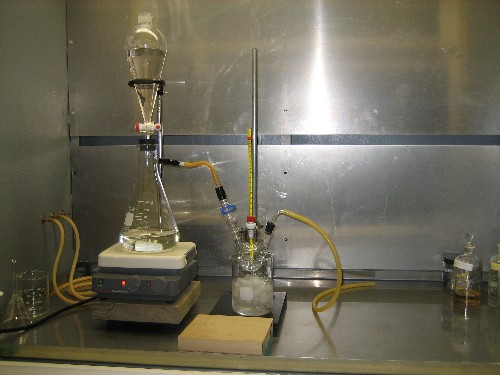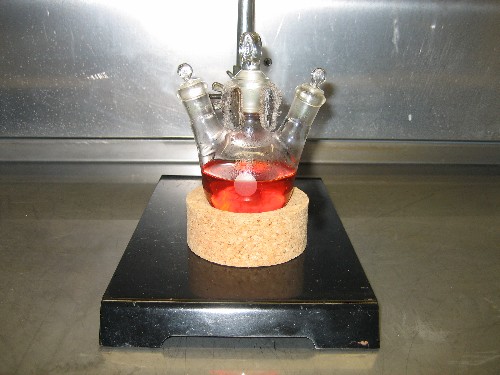Magpie
lab constructor
    
Posts: 5939
Registered: 1-11-2003
Location: USA
Member Is Offline
Mood: Chemistry: the subtle science.
|
|
dimethylglyoxime
Dimethylgyoxime can be used for the qualitative and quantitative determination of nickel.
I recently completed a synthesis of this using MEK as a starting material. The alpha carbon hydrogens are active and can be replaced by an oxime
group using HNO2 generated in situ. The 2nd oxime group is then introduced at the carbonyl carbon using hydroxylamine.
The HNO2 is produced in a most interesting way. Ethyl nitrite gas is generated using ethanol, NaNO2, and H2SO4. The gas is introduced to the
acidified MEK at an easily controlled rate using an apparatus like I show in the attached picture. When the MEK has been fully treated with the gas
it turns a deep orange-red which is the biacetyl monoxime. The lab smells of butterscotch. See picture in the next post.
My yield was 46% compared to an expected 60%. Melting point was 241C which was right on. The dimethylgyoxime product was a voluminous white crystal.
[Edited on by Magpie]

The single most important condition for a successful synthesis is good mixing - Nicodem
|
|
|
Magpie
lab constructor
    
Posts: 5939
Registered: 1-11-2003
Location: USA
Member Is Offline
Mood: Chemistry: the subtle science.
|
|
And the biacetyl monoxime:

The single most important condition for a successful synthesis is good mixing - Nicodem
|
|
|
Fleaker
International Hazard
    
Posts: 1252
Registered: 19-6-2005
Member Is Offline
Mood: nucleophilic
|
|
Very nice! Could you give reaction conditions (temperature, time, reagent masses/concentrations) and specifics. I think this is pretty neat. Smelled
of butterscotch eh? Now I'm interested, I love butterscotch  ! !
Neither flask nor beaker.
"Kid, you don't even know just what you don't know. "
--The Dark Lord Sauron
|
|
|
12AX7
Post Harlot
    
Posts: 4803
Registered: 8-3-2005
Location: oscillating
Member Is Offline
Mood: informative
|
|
Oooooh, now I wish I had o-chem hardware. Butterscotch...*droolz*
|
|
|
Magpie
lab constructor
    
Posts: 5939
Registered: 1-11-2003
Location: USA
Member Is Offline
Mood: Chemistry: the subtle science.
|
|
Heh heh.  Yes, it is the smells as much as anything that draws me to organic
synthesis. Yes, it is the smells as much as anything that draws me to organic
synthesis.
Fleaker I can give you what you need I think without typing in the whole procedure.
In the gas generator (1 liter suction flask with a 500mL dropping funnel):
C2H5OH + NaNO2 + H2SO4 --> C2H5ONO + NaHSO4 + H2O
In the reaction vessel (100 mL 3-neck):
C2H5OH + H2O (W/HCl) ----> HONO2 = C2H5OH
MEK + HNO2 --> CH3C(=NOH)COCH3
Later in a 1 liter beaker:
CH3C(=NOH)COCH3 + H2NOH --> CH3C(=NOH)C(=NOH)CH3
+ H2O
1. Load the gas generator with 300mL water, 40g of NaNO2, and 15mL of 95% ethanol.
2. Load the dropping funnel with 300 mL water, 15 mL 95%ethanol, and 25mL con sulfuric acid.
3. Load the reaction vessel with 45 mL MEK and 3 mL con hydrochloric acid.
The gas is introduced into the reaction vessel via a glass tube (6-7mm dia).
CAUTION: ethyl nitrite is a vasodilator and must not be breathed. I vented the excess to the suction of my fume hood. Other methods would include
absorption in NaOH solution, or withdrawal via a hydroaspirator. My procedure shows the use of 2ea NaOH solution wash bottles in series with the
delivery tube of the first bottle just below the liquid surface.
4. Add the dropping funnel solution to the gas generator at about 1-2 drops/sec. This will produce a nice steady stream of gas bubbles into the
reaction vessel. The reaction is exothermic and the temperature will eventually rise. Keep it between 45-55C by raising or lowering the ice bath.
5. Prepare a 1 liter beaker with 300mL H2O, 28 g of hydroxylamine hydrochloride, and 33g of Na acetate.
[I believe the acetate forms a buffer solution which keeps the pH at 4, which is optimal for the oxime formation.]
6. With constant stirring, pour the biacetyl monoxime solution into the 1 liter beaker. Heat over a wire gauze on a ring stand until the temperature
is 75C with constant stirring. Remove from the burner, cover with a sheet of paper, and let stand overnight.
7. Collect the crystalline product on Buchner funnel, washing with 4 ea 25mL portions of cold water. Then wash with 15mL ice cold acetone. Dry in
an oven at 80C.
If you have any questions just fire away. Also, if you make this, let us know. 
The single most important condition for a successful synthesis is good mixing - Nicodem
|
|
|
12AX7
Post Harlot
    
Posts: 4803
Registered: 8-3-2005
Location: oscillating
Member Is Offline
Mood: informative
|
|
And when ya do, Fleaker, send me a few hundred grams, I've been meaning to seperate nickel out of a few solutions that aren't crystallizing well.
Can DMG be freed from nickel with acid or base or reducing agent, or is the complex strong enough that it must be charred?
Tim
|
|
|
Fleaker
International Hazard
    
Posts: 1252
Registered: 19-6-2005
Member Is Offline
Mood: nucleophilic
|
|
I think I have a couple hundred grams of hydroxylamine, maybe kilograms and dimethylglyoxime is expensive (at least for me, but anyone with good
sources, don't be shy!) so this is definitely added to the list!
As far as the DMG freeing goes...I'd really have to think about it. Most of the time that I've used it was for very small samples just to test for
nickel, never tried to save any.
Neither flask nor beaker.
"Kid, you don't even know just what you don't know. "
--The Dark Lord Sauron
|
|
|
guy
National Hazard
   
Posts: 982
Registered: 14-4-2004
Location: California, USA
Member Is Offline
Mood: Catalytic!
|
|
I've been trying to make hydroxylamine and potassium nitrite all week so I could do this. lol
|
|
|
not_important
International Hazard
    
Posts: 3873
Registered: 21-7-2006
Member Is Offline
Mood: No Mood
|
|
OrgSyn entry for the process, including NH2OH
http://www.orgsyn.org/orgsyn/pdfs/CV2P0204.pdf
Nice work Magpie. I remember someone in my ochem classes had to make dimethylglyoxime, starting with acetic and propionic acids to make MEK. Their
bench went from the rather stinky acids to that of MEK and then onto that butterscotch-like odor you describe.
12AX7 - what's in the nickel solutions? You can break up the complex using wet methods, but it's a rather expensive way to separate nickel.
|
|
|
Magpie
lab constructor
    
Posts: 5939
Registered: 1-11-2003
Location: USA
Member Is Offline
Mood: Chemistry: the subtle science.
|
|
guy: I struggled with making KNO2 also. I used the classic reduction of KNO3 with molten lead using a 6" iron frying pan and a bunsen burner. I
found that I really had to pour the heat to it and used MAPP gas instead of propane to get a higher temperature. When finished you shouldn't see much
elemental lead in the pan. I considered this procedure somewhat risky even with my fume hood. I usually had to turn the hood off as it sucks away
too much heat. I now buy my NaNO2. Now that I have "making it" out of my system I think this is a much better way to go.
I don't know anything about making hydroxylamine.
The single most important condition for a successful synthesis is good mixing - Nicodem
|
|
|
Sauron
International Hazard
    
Posts: 5351
Registered: 22-12-2006
Location: Barad-Dur, Mordor
Member Is Offline
Mood: metastable
|
|
Diacetyl IS butterscotch. So named because it turns up as a congener in whiskey making.
Nice work, @Magpie!
|
|
|
12AX7
Post Harlot
    
Posts: 4803
Registered: 8-3-2005
Location: oscillating
Member Is Offline
Mood: informative
|
|
I thought diacetyl was butter, not butterscotch?
Tim
|
|
|
kmno4
International Hazard
    
Posts: 1495
Registered: 1-6-2005
Location: Silly, stupid country
Member Is Offline
Mood: No Mood
|
|
Mmmmmm....
According to:
A Practical and User-Friendly Method for the Selenium-Free One-Step Preparation of 1,2-Diketones and their Monoxime Analogs (Synlett,
2004)
there is no need to use any alkyl nitrite to prepare oximes.
They use THF(or dioxane)/NaNO2/HClaq to prepare these compounds.
More, there is suggestion that oximes (isonitrosoketones) of 1,2-diketones can be obtained in H2O/NaNO2/HClaq
in the case of soluble ketones.
My question is: Has anybody ever tried to prepare monooxime of biacetyl from MEK in this or similar way ??
[Edited on 24-7-2007 by kmno4]
Attachment: oximeTHF.pdf (61kB)
This file has been downloaded 1959 times
|
|
|
dedalus
Hazard to Self
 
Posts: 60
Registered: 13-4-2007
Location: New York
Member Is Offline
Mood: No Mood
|
|
diacetyl?
I read not too long ago that this compound, which sounds innocuous enough, caused really serious pulmonary damage to some guys who worked with it in a
microwave popcorn factory. To the point where one of them needs a lung transplant.
Not sure what the exposure conditions were, but, some caution might be in order.
http://www.occupationalhazards.com/News/Article/54818/OSHA_L...
[Edited on 24-7-2007 by dedalus]
[Edited on 24-7-2007 by dedalus]
[Edited on 24-7-2007 by dedalus]
|
|
|
not_important
International Hazard
    
Posts: 3873
Registered: 21-7-2006
Member Is Offline
Mood: No Mood
|
|
| Quote: | Originally posted by dedalus
Not sure what the exposure conditions were, but, some caution might be in order. |
Chronic (long term) exposure to moderate levels. It's not like phosgene or chlorine, although it's not a bad idea to minimise exposure.
You breath a little diacetyl every time you smell butter or cheese.
|
|
|
fusso
International Hazard
    
Posts: 1922
Registered: 23-6-2017
Location: 4 ∥ universes ahead of you
Member Is Offline
|
|
Thx to rhodanide, I found this great info
|
|
|